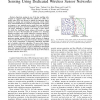152
click to vote
GLOBECOM
2010
IEEE
14 years 10 months ago
2010
IEEE
There are many key problems of decision making related to spectrum occupancies in cognitive radio networks. It is known that there exist correlations of spectrum occupancies in tim...
108
Voted
GLOBECOM
2010
IEEE
14 years 10 months ago
2010
IEEE
Abstract--Cognitive radio networks require fast and reliable spectrum sensing to achieve high network utilization by secondary users. Current optimization approaches to spectrum se...
100
click to vote
GLOBECOM
2010
IEEE
14 years 10 months ago
2010
IEEE
The concept of dynamic spectrum access (DSA) enables the licensed spectrum to be traded in an open market where the unlicensed users can freely buy and use the available licensed s...
130
Voted
WIOPT
2010
IEEE
14 years 11 months ago
2010
IEEE
—Cognitive radio networks provide the capability to share the wireless channel with licensed (primary) users in an opportunistic manner. Primary users have a license to operate i...
97
Voted
WCNC
2010
IEEE
14 years 11 months ago
2010
IEEE
— Previous works studied the effect of many system parameters on spectrum sharing opportunities where secondary users access the spectrum of primary users. However, a parameter t...
124
Voted
PKDD
2010
Springer
14 years 11 months ago
2010
Springer
Abstract. The eigenspectrum of a graph Laplacian encodes smoothness information over the graph. A natural approach to learning involves transforming the spectrum of a graph Laplaci...
87
Voted
INFOCOM
2010
IEEE
14 years 11 months ago
2010
IEEE
Abstract—Spectrum sensing is one of the key enabling technologies in Cognitive Radio Networks (CRNs). In CRNs, secondary users (SUs) are allowed to exploit the spectrum opportuni...
118
click to vote
INFOCOM
2010
IEEE
14 years 11 months ago
2010
IEEE
Abstract—This paper presents the first analytical study of optimal investment and pricing decisions of a cognitive mobile virtual network operator (C-MVNO) under spectrum supply...
136
click to vote
TWC
2008
14 years 12 months ago
2008
Spectrum sensing is the key enabling technology for cognitive radio networks. The main objective of spectrum sensing is to provide more spectrum access opportunities to cognitive r...
78
Voted
MCS
2007
Springer
15 years 12 days ago
2007
Springer
Spectra of linear operators play an important role in various aspects of applied mathematics. For all but the simplest operators, the spectrum cannot be determined analytically an...





